The
"Stylish" Sixteens
[ with styling codes beginning "42..." ]
In this page are illustrated, by
means of line drawings1, the various Fleetwood
bodies with styling codes beginning "42...". These were, in my opinion,
the most stylish of the vee-sixteen offerings and included the majority of open cars and
coupe styles. Many were built at the old Fleetwood plant in Pennsylvania.
If the sixteen-cylinder cars in the "41..." group may be compared to the luxurious Cadillac Sixty
Special series of the late thirties through the late sixties, and those in the "43..." group to the Series 62 cars of the
fifties and sixties, then a similar comparison might place this next group on the same
plane as the top-of-the-range Eldorado models of the fifties and sixties.
With a couple of exceptions that you
will easily pick out below, the sixteens in this series have a typical body styling
characteristic that I have tried to highlight in the artist's view below. It is the
gracefully curved body sill, also known as a "coach
sill", reminiscent of the elegant horse-drawn coaches and carriages of the 18th and
19th centuries. In this group are found a variety of windshields and belt moldings;
the latter mostly are horizontal though, in some cases, no belt molding is present at all.
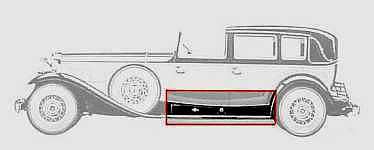
The common styling characteristic of the majority
of sixteen-cylinder cars with a job or style code beginning "42..."
is the curved or "coach" sill [although there are exceptions!]
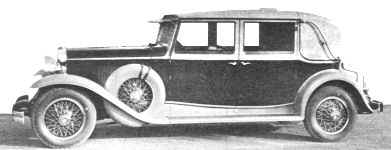
The curved, sweeping sill on this unique custom
creation by Fleetwood, built in the summer of 1929 on a V-8 chassis stretched to
152"
and known as the French Brougham, provided the basic sill design for
1930-31 V-16 models with Fletwood style numbers starting "42.."
_________________________________
1 Included
in the product catalog for the Vee-sixteen models is an envelope of designer's drawings of
the most common body styles offered; drawings are not available for all styles so, where
there was none, I have used an existing drawing and made appropriate modifications to
better illustrate the missing style; sometimes I have had to use my imagination so
please do not consider these "montages" as reflecting a factory original car
Here are
Fleetwood's bespoke "coach sill"
models on the V-16 chassis
[listed in ascending order of rarity]
Style 4235
[94 units]: a 2-passenger convertible coupe, with rumble seat, golf-bag
doors and "suicide doors", costing $6900. Article in SIA106, p.34.
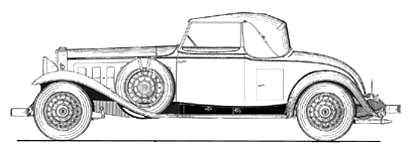
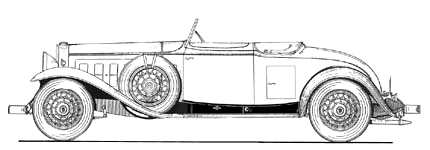
This lovely body style featured a flat, one-piece
windshield with slim windshield posts, golf-bag doors on either lower quarter panel and a
special, horizontal belt molding. Below are two artist's renderings of that style;
as you can see,
these early drawings show this style with the "43..." type of body sill,
although none were built that way
[ unlike Fleetwood roadsters, in the open position, the folded convertible top lies
flush with the rear body ]
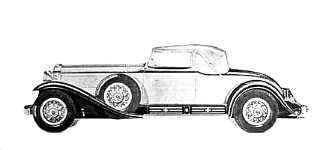 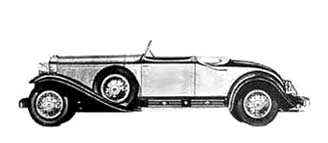
These two artist's renderings are excerpted from an
early catalog of Fleetwood proposals for the new vee-sixteen chassis;
the car is shown here with a straight body sill, whereas it was built only with the
regular curved, or "coach" sill
Style 4260 (1)
[85 units - of which at least one special, dual-cowl sport phaeton,
described later in this section]; this is a 5-passenger phaeton with special secondary
cowl and cranking secondary windshield, special front windshield, clock and speedometer
duplicated in rear compartment, forward-opening doors. One of these was among the six cars
taken to Europe in June 1930 for a promotional tour
(photos in the SS, Sep, 1967, p.12 and Oct. 1967, pp8-9. Articles in SIA106, p.64, CC&CC 10/1987, SSA
1974, pp. 9-10 [story of the "Fire Wagon" or "Red Devil", returned to
Cadillac by Mrs. Little, the widow of first owner]. Such a car was used also in the movie The
Carpetbaggers, starring Alan Ladd (story in CC, 5/69, cover and
pp.30-33; details include front ensemble, side, rear trunk, driver's seat,
"6-shooter" door handles [car has since been restored back to original
state]). This Fleetwood
style was listed at $6150 on the price-list for 1.1.1930, and was increased to $6500 on
that for 10.15.1930.
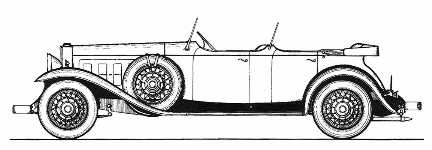
Easy ID: the curved coach sill and slim belt molding
Style 4276
[70 units]: a popular 2-passenger coupe, rumble seat, golf-bag doors, see
designer's drawing below, costing $6850. Article in SIA106, p.64, CLC 30th
Anniversary issue, inside front cover. This style features the Madame X
windshield and chrome window frames; it is not a full-fledged Madame X
model. Pics of body details such as rumble seat, hood vent doors, accessory protective
step plate, golf-bag door are available in CC&CC 11/1969, pp.36-37.
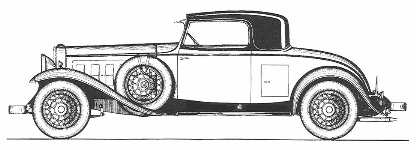
Easy ID: the curved coach sill and so-called
Madame X type windshield
Style 4291
[14 units]: a town car with spacious rear passenger area, large quarter
windows. Flat, canted windshield with front door following angle of windshield post,
"suicide" doors front and rear, full width auxiliary seating, cost $8750.
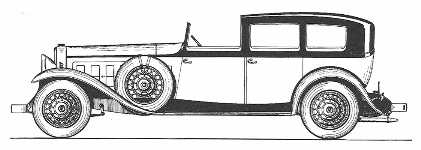
Easy ID: the curved coach sill, the long rear body
and the large ¼ -windows
Style 4220
[9 units]: a town car with spacious rear passenger area, small quarter
windows, flat slanting windshield, front door follows angle of windshield,
"suicide" doors front and rear, short, non-functional landau bars above
belt line, leather roof covering, cost $7300. Article in SIA106, p.34.
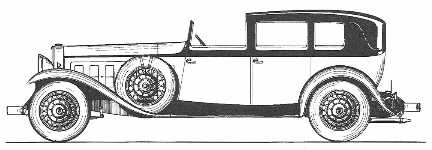
Easy ID: the curved coach sill, long rear body and
small ¼ -windows
Style 4208
[7 units]: a special 5-passenger limousine with two small auxiliary
seats, flat windshield, "suicide" doors front and rear, light-colored
leather roof covering, non-funtional landau bars above belt line, large sun visor,
rack-mounted travel trunk.
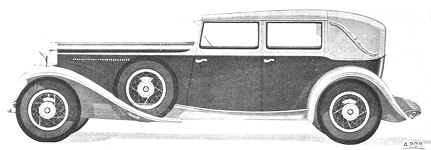 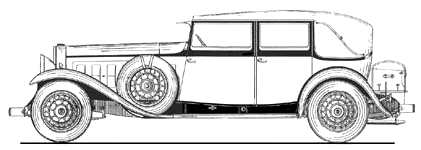
Easy ID: the curved coach sill and light-colored top
material; this style was already on the Fleetwood books in 1929;
Style 4212
[6 units]: a town car, short rear body, no quarter windows, flat slanting
windshield, front door follows angle of windshield, "suicide" doors front and
rear, non-functional landau bars above belt line, leather roof covering.
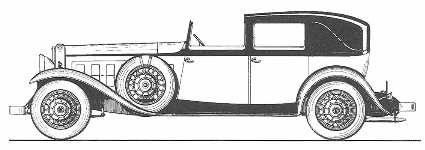
Easy ID: the curved coach sill, short rear body and
blank rear quarters
Style 4225
[6 units]: a town car, spacious rear body area, no quarter windows, flat
slanting windshield, front door follows angle of windshield, "suicide" doors
front and rear, non-functional landau bars above belt line, leather roof covering, large
folding auxiliary seats, cost $6625. Article in SIA106, p.64.
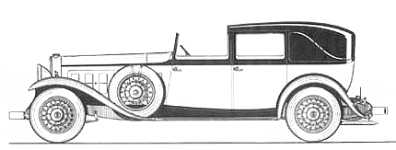
Easy ID: the curved coach sill, long body and blank
rear quarters
Style 4264
[4 units]: a square-edged or razor-edged town brougham
with"suicide" doors front and rear, no quarter windows, flat slanting
windshield, vertical front foor line. Cost $9200.
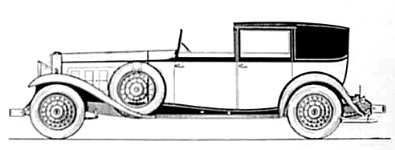
Easy ID: the curved coach sill, short rear body,
razor-edged rear styling and blank rear quarters
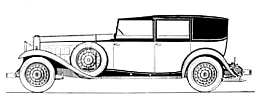
The same car with the canopy in place over the
driver's compartment
Style 4207
[3 units]: a special, 2-passenger hardtop coupe with rumble-seat, light
colored leather roof covering, canted "V" windshield, "suicide" doors,
long golf-bag door, non-functional landau bars (I've seen this one confused with unique
style #4206, below).
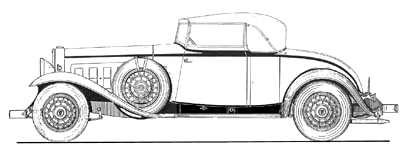
Easy ID: the curved coach sill, canted "V"
windshield,
long golf-bag door, special belt molding
Style 4264B (1) [3 units]:
a square-edged or razor-edged town brougham with dual sill (horiozontal at the front and
mail-coach sill or "boot-toe" at the rear), "suicide" doors front and
rear, no quarter windows, flat slanting windshield, front door edge follows angle of
windshield; cost $9700.
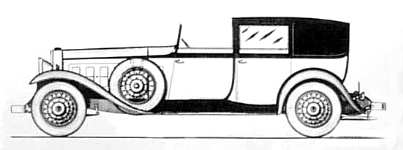
Easy ID: razor-edged rear body styling,
"boot-toe" coach sill
Style 4264B
(2) [3 units]: similar to the above car but dressed
with French canework on the lower, rear body - a fashionable trend in the teens and
twenties. Article in SIA106, p.35 and CS11, p.49.
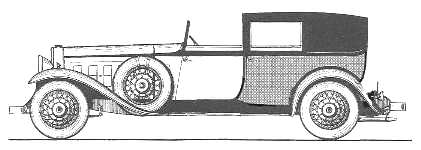
Easy ID: as above, but French canework applied to
rear body
Style 4280 [3
units] a 4-passenger special phaeton, costing $7350.
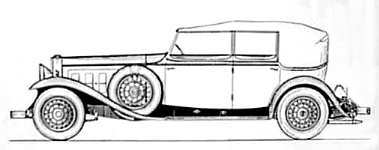
Easy ID: the curved coach sill, exposed door hinges,
special belt molding
Style 4275C
[2 units]: presumably a very similar body style to unique job #4275,
below, but with collapsible roof over the rear seat passengers, in the true landaulet
tradition.
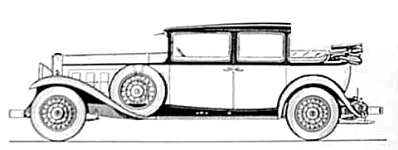
Easy ID: the curved coach sill, long body,
collapsible rear quarters
(this is my own "montage"; I am not too sure about that windshield
though)
Style 4285
[2 units - one delivered to GM facility at Antwerp]: a 5-passenger
convertible Victoria, special, slanting "V"-type windshield, front "suicide
doors" following the slant of the windshield post. Functional landau bars.
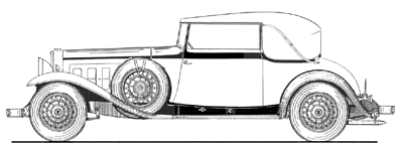
Easy ID: the curved coach sill, Victoria convertible
body
Style 4275 [unique]: presumably a special order for a client who
liked the coach sill of the Fleetwood styles beginning with digits "42". No
details or photos available.
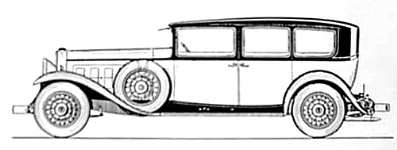
Easy ID: the curved coach sill, long body, large ¼
-windows
(again, this is my own "montage"; I am not too sure about that
windshield)
Style 4200
[unique]: a 7-passenger sedan [no partition]
with two full-width auxiliary seats and light-colored leather roof covering [for full
description, see Database section on Fleetwood style codes,
Part 1 and the V-16 section devoted to this
particular car].
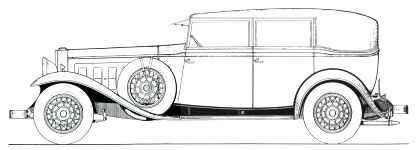
Easy ID: the curved coach sill, short body,
light-colored hard top. No ¼ -windows
Style 4206
[unique] a special, 2-passenger hardtop
coupe with rumble-seat, light colored leather roof covering, canted "V"
windshield, "suicide" doors, long golf-bag door, non-functional landau bars
(I've seen this one confused with unique style #4207, above). The actual car
features in addition three large, exposed, chrome-plated door hinges (not shown on the
factory drawing). This model is illustrated in the German
"Motor" magazine for July, 1930.
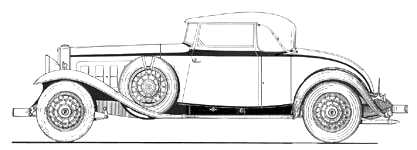
Easy ID: the curved coach sill, canted "V"
windshield,
long golg-bag doors, exposed door hinges [not shown on line drawing]
Style 4212C
[unique]: a town landaulet, short raer body,
no quarter windows, flat slanting windshield, front door follows angle of windshield,
"suicide" doors front and trear, leather roof covering with functional landay
bars and folding roof portion over rear seat passengers.
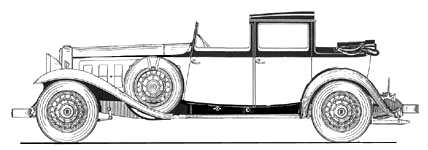
Easy ID:similar to style #4212 (above) but with
opening rear roof (landaulet styling)
Style 4220B
[unique]: a town car, spacious rear body
arae, small quarter windows, flat slanting windshield, front door follows angle of
windshield, "sucide" doors front and rear, plain metal roof, no imitation
landau bars (?).
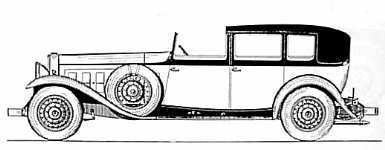
Easy ID: similar to style #4220, above, but painted
metal roof finish
Style 4225C
[unique]: a town landaulet with spacious
rear body area, no quarter windows, flat slanting windshield, front door follows angle of
windshield, "suicide" doors front and rear, functional landau bars, leather roof
covering, large folding auxiliary seats, opening roof portion over rear seat passengers.
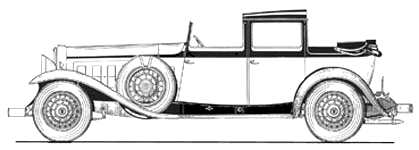
Easy ID: similar to style #4225, above, except
folding rear roof portion ( landaulet styling)
Style 4257A
[unique]; a 4-passenger sport phaeton with
folding secondary cowl and folding secondary windshield, special front windshield and
equally special belt molding; also special convex trunk curve. Despite styling code
starting with digits "42", this car had a straight sill, with forward-opening
doors like style 4260. Late Extra (2009): This car or one very much like it, has survived.
The main difference between the drawing, below, and the actual survibing car is the
absenve of the seconadry folding cowl, as used on Fleetwood's sport phaeton models. The
survivor also has a diffrent rear treatment, more like the car below (#4257H) and the door
handles are mounted lower in the door panels.
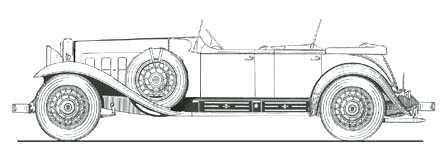
Easy ID: horizontal sill, special belt molding, sport
phaeton style
with secondary cowl and folding windshield
Style 4257H [unique]: a large, 7-passenger convertible touring car.
This was a standard Fleetwood offering in 1930 on the V8 chassis. The "H" suffix
in the styling code suggests increased interior height with folding top in place. Front
"suicide" doors. Late Extra (2009):
a combination of TWO unique Fleetwood body styles (#4257-A and #4257H) appears to
have survived. The owner, Joe Moore, left this message on the Cadillac-LaSalle
Club, Inc.'s message board on June 21, 2002: Have 7-pass one of a kind
with scroll hood. Need any parts & accessories including any information of original
sales data. Delivered new to a dealer in NYC. Fleetwood body #16-688, engine # 701849.
Currently in complete restoration. Any help will be greatly appreciated. Joe.
In the 2002 CLC Directory the owner of that survivor is listed as B. Massman, CA.
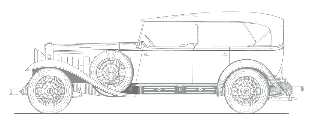
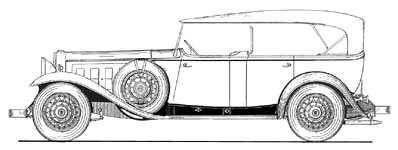
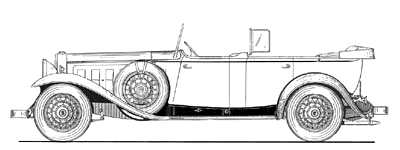
Easy ID: curved coach sill, long rear body, secondary
windshield, convertible touring car style
[ the original factory drawing, upper image, shows a horizontal sill but actual car
has coach sill ]
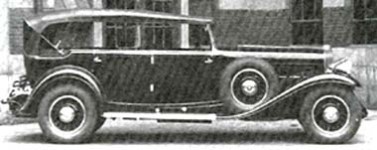
Factory photo shows correct curved sill for Fleetwood
"42.." group
Style 4260 (2) [unique, though included in the total for style 4260]:
This is a unique RHD V16, built in 1930 for H.H. the Maharajah of Tikari. Read the story
and see the photos in CC&CC, 9/1983, pp.34-38; details include front ensemble,
rear trunk, engine, RH steering.

Easy ID: like regular style #4260 but with right-hand
drive
Style 4260 (3)
[unique, though included also in the total for style
4260]: Unlike standard 4260 cars, this one was fitted at the factory with
a folding dual-cowl and secondary folding windshield. Formerly owned by friends, Ray and
Dorothy Radford, OR, it was sold in the mid-eighties to Bob Laravee who restored it
completely.
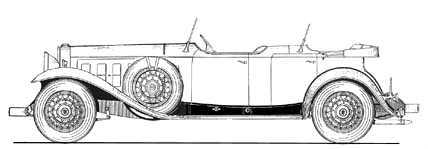
Easy ID: like regular style #4260 but fitted out as a
sport phaeton
with secondary cowl and folding windshield
Style 4260A
[unique]: a special sport phaeton with dual
cowl and crank down secondary windshield. Although the styling code starts with
"42", the car features the "43" series hood with the curved, raised
panel. There was no belt molding. The car had tufted broadcloth upholstery, which was
somewhat out of place in an open car. This was one of the official cars used at the 1930
Indianapolis race.
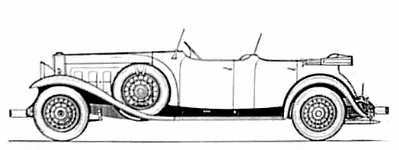
Easy ID: like regular style #4260 but fitted with
front hood from "43..." series sixteens;
tufted (piped) cloth upholstery (unusual in a convertible body style)
Style 4262
[unique]: This is a custom limousine
style (division) for seven passengers. There appear to be no factory photo, artist's
rendering or designer's drawing of this Fleetwood job. The line drawing below
is my own impression of the car, based on the description included in factory records.
This model had a flat, slanted windshield, the front door edge followed the windshield
angle, "suicide" doors front and rear, a leather roof covering, no ¼-windows
and non-functional landau bars.
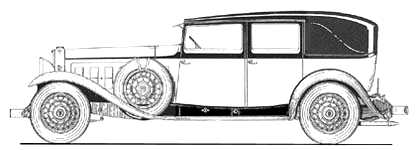
In the absence of an original designer's drawing for
unique style #4262, I created
this montage from style #4275 [windshield and front roof] and #4225 [rear roof]
|
![]()